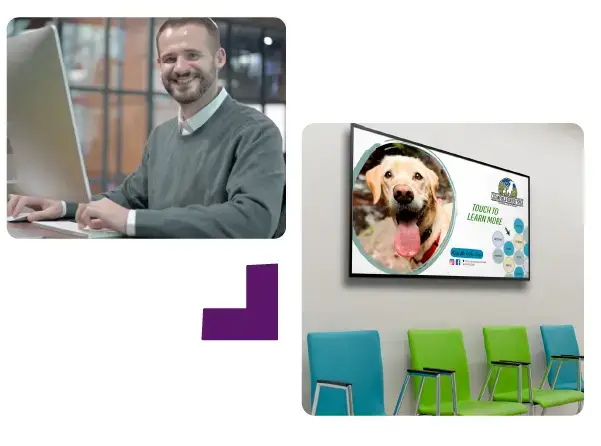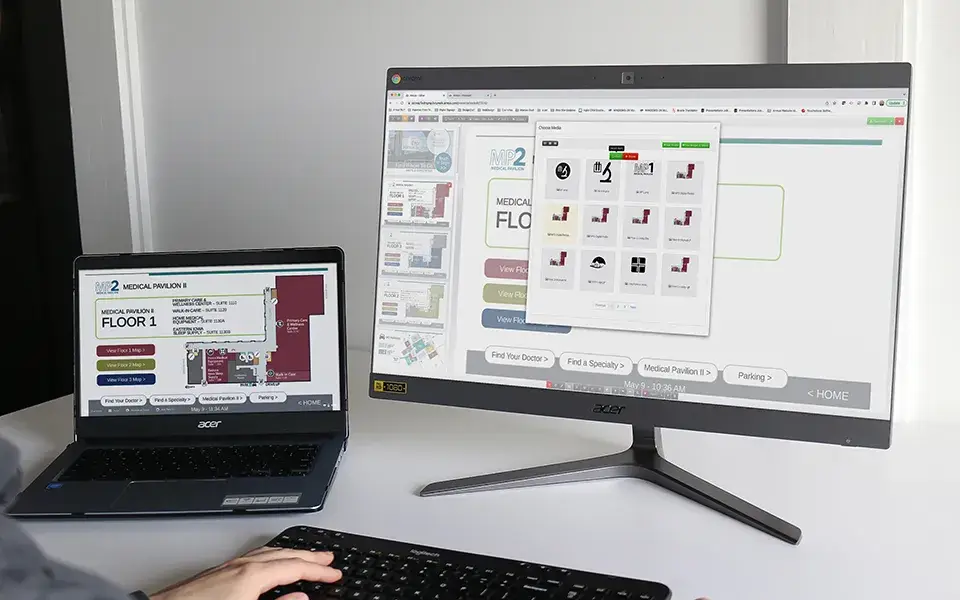Digital Signage Software
Cloud-Based CMS Software with the Best Features
Arreya is more than a digital signage content management system. Our enterprise software was designed to have one of the best Creative Studio design suites on the market. The solution empowers marketers, creative teams, and digital signage managers to create a wide variety of dynamic, interactive and touch graphics. It also has one of the most robust scheduling tools that allows up to the minute playback scheduling. The design canvas shows exactly what screens will play and can be pushed to go-live, with a click, in real-time with no lag or drop. Our software is easy-to-use, turnkey to implement, and requires zero lift from your IT team to manage. We provide live, US-based tech support and optional priority e-ticketing triage (with a paid subscription to Arreya Care). You get everything you need to do digital signage well from the moment you start using our software.
Incredibly Easy CMS Software
The most powerful digital signage solution on the market is actually easy to use. Arreya is so easy, anyone can become a digital signage pro. Our solution has a low learning curve, drag-and-drop design for fast content creation, is cloud-based, and scales to grow with the needs of your organization. Plus, get an unlimited number of seats with each subscription to give access to everyone on your team.
Easy DIGITAL SIGNAGE Software DOES IT ALL
Create, Publish, and Manage Digital Signage
Digital signage software from Arreya is like getting several software solutions in one. With a subscription, your team can be up and running quickly, and they’ll have every resource they will ever need to master digital signage. Empower them to build engaging promotions, create brand awareness, share company goals, foster relationships, and deeply engage with audiences.


Fresh and Dynamic Content in 10 Minutes
Imagine having a fully-loaded, content creation toolbox to build and create any digital signage presentation you want. With Arreya, it’s a reality. Our Creative Studio has every tool you’ll ever need to add video, animation, and graphics. Plus, we provide royalty-free images and FREE templates right in the solution. Create multi-page digital signage presentations and simplify content management with Arreya.

No Screen "Zones" or Format Issues
When a presentation is ready, pushing to screens is as easy as a click. Our canvas view is designed to match what will show on any screen. What you’ve designed is EXACTLY what will be shown. No font mishaps, fuzzy graphics, or large format issues here. If it’s clear on your canvas, it will be clear on your screen. Simply click the “PUSH LIVE” to go live. It’s really that easy.

Schedule Unlimited Presentations
Arreya brings scheduling digital signage to another level and gives you the flexibility to show an unlimited number of presentations. We make it easy to add, prioritize, and change presentation flow with a click. Make multiple changes to scheduled presentations without having to wipe and redo the entire schedule. It’s a great way to add new messages to a weekly flow or add last-minute welcome slides, alerts, and more. Schedule content to the minute with Arreya.
- Recurring Schedules
- Time Zone Enabled
- Set A Priority Schedule
- Unlimited Scheduling
Get leading CMS software and a display with Arreya.
What You Get With Arreya Software
A fully-loaded and easy digital signage content management system with a leading Creative Studio.
Essentials
- CMS Interface
- Creative Studio
- Offline Play
- Analytics
- Device Agnostic
- Auto Updates - No Downloads
- 100% Cloud HTML Platform
- System Agnostic
User Management
- Number of User – Unlimited
- User Roles / Permisions
- Secure Single Sign-On
- User Activity Logs
- User Password Reset
- Remote Login
Creative Studio Features
- 100% Entirely in the Cloud
- Single Page Presentations
- Multipage Presentations - Powerpoint, etc.
- Build Multipage Touch Screens
- Templates - 500+
- Create and Save Your Own Templates
- Fonts - 1500+ Google Fonts
- Live Creation- WYSIWYG
- Zone Free - Open Canvas
- Horizontal or Vertical Canvas
- Build Any Canvas Size - Video Walls
- CSS Styling - Apply to Any Widget
- Royalty Free Photos & Video - Pixabay
- Slide Show - Assign Each Slide a Playtime
- Slide Show - Mix Images With Video
- Draw Lines, Circles, Rectangles Anywhere
- Overlays and Transparency
- Page Timing with Transitions
- Rotate Any Object
Add On Features & Widgets
- Time & Date
- Hebrew Date
- Text Scrolling
- Web - URL
- Canva Integration
- Calendar
- QR Code Generator
- RSS Feeds - News, Sports, Stock
- Weather Forecasts
- Google - Slides, Sheets, Forms
- Google - Calendar, App Sheet, Maps
- Alerts
- Power BI
- Metrics
- Trivia
- Holiday & Observances
- API Integrations
- HTML Code Field
- Live Stream
- Webcam Feed
- Google Translate
Scheduling
- Comprehensive Scheduling Options
- Recurring Schedules
- Priority Scheduling
- Time Zone Enabled
Content Management
- Cloud Storage - Unlimited
- Upload - Up to 2 Gig files
- Video Optimization - Built-In
- Accepts Vector Files - AI, SVG, PDF
- Supports Transparent - PNG, PSD, SVG, AI
- Plays Animated Gifs
System Management and Integration
- Cancel Any Time - No Contract
- Monthly Plans
- Remote Device Management
- Device Health Monitor
- Device Location Maps
Support and User Experience
- Uptime - 99.9%
- Standard Software Support
- Call and Email
- US Based Support Team
- Training
- Onboarding


